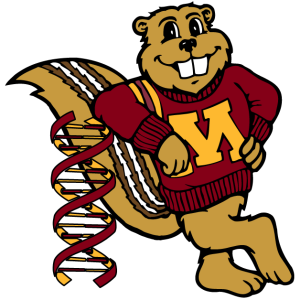Join the Engelhart Lab at the University of Minnesota
Our laboratory studies nucleic acids, both as targets of basic research and tools to study complex biological systems. A few projects our lab is currently working on are given below:
RNA imaging: GFP and other fluorescent proteins have enjoyed over twenty years of extraordinary success as tools for cellular and whole-organism imaging and readout. The explosive proliferation of new roles for RNA in vivo has led to a need for corresponding nucleic acid imaging tools. We are working towards engineering and selecting brighter, more photostable, better-folding RNA imaging tools for complex systems, such as primary neuron cultures and whole model organisms.
Noncanonical RNA structures in disease: A wide range of nucleic acid structures exist beyond the well-known extended Watson-Crick duplex, such as four stranded G Quadruplexes, and noncanonical duplex structures, such as supercoiled and condensed states. We are studying the roles of noncanonical nucleic acid structures in regulation of gene expression and their possible roles in disease states.
Origins of life and synthetic cells: We are interested in the deployment of functional nucleic acids, as well as protein catalysts, in liposomal compartments, and interactions between components of these assemblies that might have occurred in primitive cells. We also have an ongoing collaboration with the Adamala lab (http://protobiology.org) using sy nthetic cells made from liposomal cell-free extracts as a means of studying complex biological systems.
nthetic cells made from liposomal cell-free extracts as a means of studying complex biological systems.
We use a wide range of techniques spanning the spectrum from chemistry to biology, from biophysics and organic chemistry to microscopy and cell/tissue culture. We are housed in the Department of Genetics, Cell Biology, and Development, a rich environment for collaborations, with numerous PIs working on a wide range of model organisms. A robust chemical biology community exists as well in the adjacent Medicinal Chemistry department. The University is located in Minneapolis, MN, a metropolitan area of 3.4M with a low cost of living that routinely ranks among the best places in the US to live.
Interested postdoctoral fellows should have a Ph.D. with a background in bioorganic, biophysical chemistry, or molecular biology, a strong publication record, excellent communication skills, and experience working in collaborative, interdisciplinary teams. To apply, please send a cover letter detailing why you are interested in our work, and how your scientific interests and expertise would be a good fit, your CV (including a list of publications and presentations), to Aaron Engelhart (enge0213@umn.edu). Please also arrange for three reference letters with contact information to be sent.
Ph.D students can join the lab through the University’s joint program in Molecular, Cellular, Developmental Biology and Genetics (MCDB&G), a joint program between GCD and the Department of Biochemistry, Molecular Biology and Biophysics (BMBB). Information about applying to the MCDB&G program can be found here.
Further information: http://aaronengelhart.com/
Adamala, Engelhart, and Szostak. Nature Comms. (2016) 11041.
Engelhart, Adamala, and Szostak. Nature Chem. (2016) 8:448-453.
Engelhart, Powner, and Szostak. Nature Chem. (2013) 5:390-394.